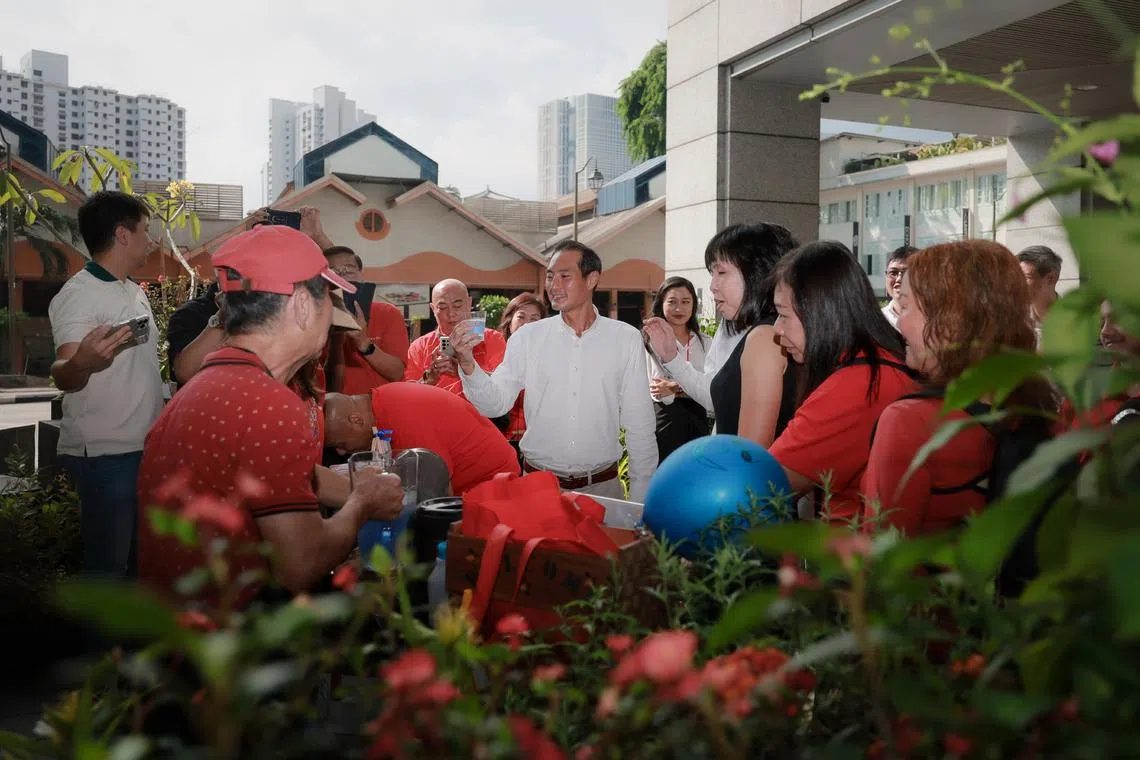New study aims to improve Singapore’s green spaces for humans and wildlife
Sign up now: Get ST's newsletters delivered to your inbox

Senior Minister of State for National Development Tan Kiat How having a cup of blue pea tea at the Pelatok Art Farm installation on April 1.
ST PHOTO: GAVIN FOO
Follow topic:
SINGAPORE – A new three-year study is under way to improve the design of green linkages in Singapore for humans and wildlife.
The study, backed by research funding of $2.75 million from the Government, will assess how green spaces such as park connectors can better facilitate connectivity for people and biodiversity, Senior Minister of State for National Development Tan Kiat How said on April 1.
“The research results could help us design better green spaces to support community activities and boost usage of these green spaces,” Mr Tan said at the launch of an exhibition showcasing research on how cities can be designed to promote health and well-being.
Led by researchers from the Singapore University of Technology and Design (SUTD), the study began in February after the Urban Redevelopment Authority (URA) and the National Parks Board (NParks) awarded it in December 2024.
Titled Well-being In The City: Innovating Healthy Living, the exhibition at The URA Centre comprises research projects centred on physical, social and mental health.
The study’s co-principal investigator, Dr Srilalitha Gopalakrishnan, said at least five types of green linkages will be assessed: park connectors, cycling paths, nature ways, parks and forest patches.
She said that while many of these green spaces already exist, they largely were not planned to be shared by humans and wildlife.
Professor Thomas Schroepfer, the lead principal investigator for the study, said that Singapore – a high-density city that aims to live with nature – is a good location for the study, which may inform city planning in other similarly dense cities.

Dr Srilalitha Gopalakrishnan and Professor Thomas Schroepfer are the principal investigators for the three-year study that aims to improve the design of green linkages in Singapore.
ST PHOTO: GAVIN FOO
Dr Srilalitha said the study will build on NParks’ ecological profiling exercise, which mapped land habitats that were important for wildlife connectivity by studying the movement of six fauna species.
One method that the SUTD team will use involves using drones to collect DNA samples left on tree canopies by animals such as insects and birds. These samples will allow researchers to know what animals use or visit particular green spaces and track their movement patterns.
Apart from the SUTD study, Mr Tan also touched on one other piece of research on show at the URA exhibition.
He cited a study by researchers from the National University of Singapore (NUS) which found that people’s perceptions of thermal comfort are affected not only by the actual temperature of the environment but also by the colours in their environment.
“This suggests that the visual elements in our neighbourhoods could be designed more purposefully, to better encourage people to go outdoors and be active,” said Mr Tan.

The Pelatok Art Farm installation outside the URA Centre on April 1 during the launch of the Well-being In The City: Innovating Healthy Living exhibition.
ST PHOTO: GAVIN FOO
This study, led by Assistant Professor Ang Yu Qian, showed that blue-related colours and higher sky visibility were perceived as less thermally comfortable, while environments with a higher proportion of magenta were generally thought of as more comfortable.
Prof Ang said the NUS team has developed an artificial intelligence model that analyses images of environments and predicts how people will perceive thermal comfort in them, with hopes of allowing urban planners and designers to assess their designs before they are implemented.
Another NUS study featured at the exhibition found that connectivity, accessibility and affordable transportation are important for older people.
Professor Elaine Ho, who led the study, said her research showed that seniors in Singapore do not only use facilities and services within their neighbourhoods but also travel much farther away to other neighbourhoods to maintain social networks.
This finding, she said, was corroborated by interviews done for the study, in which seniors said they were socially closest to family members, followed by friends and then neighbours.
“It tells us that as much as ageing in place is important for convenience, and for older Singaporeans who are more frail, those who are physically active desire to connect with their key social contacts in other parts of Singapore as well,” said Prof Ho.
Mr Tan said that some research showcased at the exhibition can be scaled up and implemented where possible to “shape Singapore into a happy and healthy city”.
The exhibition runs till May 31 and admission is free.
Ng Keng Gene is a correspondent at The Straits Times, reporting on issues relating to land use, urban planning and heritage.


